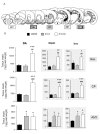P-cresol Alters Brain Dopamine Metabolism and Exacerbates Autism-Like Behaviors in the BTBR Mouse
- PMID: 32294927
- PMCID: PMC7226382
- DOI: 10.3390/brainsci10040233
P-cresol Alters Brain Dopamine Metabolism and Exacerbates Autism-Like Behaviors in the BTBR Mouse
Abstract
Background: Autism Spectrum Disorder (ASD) is a neurodevelopmental disorder characterized by deficits in social interaction/communication, stereotypic behaviors, restricted interests, and abnormal sensory-processing. Several studies have reported significantly elevated urinary and foecal levels of p-cresol in ASD children, an aromatic compound either of environmental origin or produced by specific gut bacterial strains. Methods: Since p-cresol is a known uremic toxin, able to negatively affect multiple brain functions, the present study was undertaken to assess the effects of a single acute injection of low- or high-dose (1 or 10 mg/kg i.v. respectively) of p-cresol in behavioral and neurochemical phenotypes of BTBR mice, a reliable animal model of human ASD. Results: P-cresol significantly increased anxiety-like behaviors and hyperactivity in the open field, in addition to producing stereotypic behaviors and loss of social preference in BTBR mice. Tissue levels of monoaminergic neurotransmitters and their metabolites unveiled significantly activated dopamine turnover in amygdala as well as in dorsal and ventral striatum after p-cresol administration; no effect was recorded in medial-prefrontal cortex and hippocampus. Conclusion: Our study supports a gene x environment interaction model, whereby p-cresol, acting upon a susceptible genetic background, can acutely induce autism-like behaviors and produce abnormal dopamine metabolism in the reward circuitry.
Keywords: autism spectrum disorder (ASD), biomarker; dopamine; mouse social behavior; p-cresol.
Conflict of interest statement
The authors declare that they have no competing interests.
Figures


Similar articles
-
Gut mobilization improves behavioral symptoms and modulates urinary p-cresol in chronically constipated autistic children: A prospective study.Autism Res. 2022 Jan;15(1):56-69. doi: 10.1002/aur.2639. Epub 2021 Nov 23. Autism Res. 2022. PMID: 34813183 Free PMC article.
-
Simultaneous Blockade of Histamine H3 Receptors and Inhibition of Acetylcholine Esterase Alleviate Autistic-Like Behaviors in BTBR T+ tf/J Mouse Model of Autism.Biomolecules. 2020 Aug 28;10(9):1251. doi: 10.3390/biom10091251. Biomolecules. 2020. PMID: 32872194 Free PMC article.
-
The microbial metabolite p-Cresol induces autistic-like behaviors in mice by remodeling the gut microbiota.Microbiome. 2021 Jul 8;9(1):157. doi: 10.1186/s40168-021-01103-z. Microbiome. 2021. PMID: 34238386 Free PMC article.
-
Review of Elevated Para-Cresol in Autism and Possible Impact on Symptoms.Int J Mol Sci. 2025 Feb 11;26(4):1513. doi: 10.3390/ijms26041513. Int J Mol Sci. 2025. PMID: 40003979 Free PMC article. Review.
-
Exploring the neurotoxic effects of microbial metabolites: A potential link between p-Cresol and autism spectrum disorders?Brain Res. 2025 Mar 1;1850:149427. doi: 10.1016/j.brainres.2024.149427. Epub 2024 Dec 26. Brain Res. 2025. PMID: 39732158 Review.
Cited by
-
Unraveling the Endocannabinoid System: Exploring Its Therapeutic Potential in Autism Spectrum Disorder.Neuromolecular Med. 2024 May 14;26(1):20. doi: 10.1007/s12017-024-08781-6. Neuromolecular Med. 2024. PMID: 38744725 Free PMC article. Review.
-
Microbiota-derived metabolites as drivers of gut-brain communication.Gut Microbes. 2022 Jan-Dec;14(1):2102878. doi: 10.1080/19490976.2022.2102878. Gut Microbes. 2022. PMID: 35903003 Free PMC article.
-
Inhibition of the Beta-oxidation Pathway of Fatty Acids and Dopamine- Beta-hydroxylase by Phenyl Derivatives of Short- Chain Fatty Acids from Gastrointestinal Clostridia Bacteria is a (the) Major Cause of Autism.Integr Med (Encinitas). 2023 May;22(2):18-25. Integr Med (Encinitas). 2023. PMID: 37363147 Free PMC article.
-
Gut microbiota and blood metabolites: unveiling their roles in hippocampal volume changes through Mendelian randomization and mediation analysis.Metab Brain Dis. 2025 Apr 12;40(4):178. doi: 10.1007/s11011-025-01611-z. Metab Brain Dis. 2025. PMID: 40220127
-
p-Cresol and p-Cresyl Sulphate Boost Oxidative Stress: A Systematic Review of Recent Evidence.Basic Clin Pharmacol Toxicol. 2025 Jul;137(1):e70065. doi: 10.1111/bcpt.70065. Basic Clin Pharmacol Toxicol. 2025. PMID: 40534235 Free PMC article. Review.
References
-
- Diagnostic and Statistical Manual of Mental Disorders: DSM-5. American Psychiatric Association; Arlington, VA, USA: 2013.
-
- Baio J., Wiggins L., Christensen D.L., Maenner M.J., Daniels J., Warren Z., Kurzius-Spencer M., Zahorodny W., Robinson Rosenberg C., White T., et al. Prevalence and Characteristics of Autism Spectrum Disorder Among Children Aged 8 Years—Autism and Developmental Disabilities Monitoring Network, 11 Sites, United States, 2012. MMWR Morb. Mortal. Wkly. Rep. 2018;67:1279. - PMC - PubMed
Grants and funding
LinkOut - more resources
Full Text Sources
Medical

